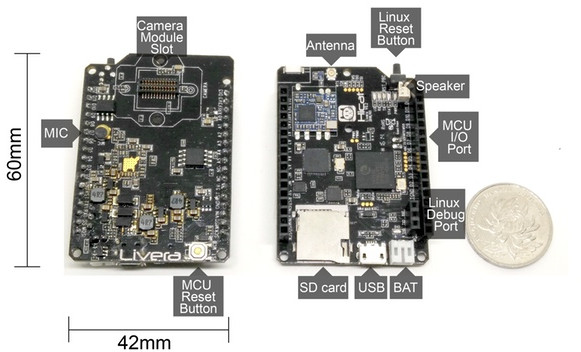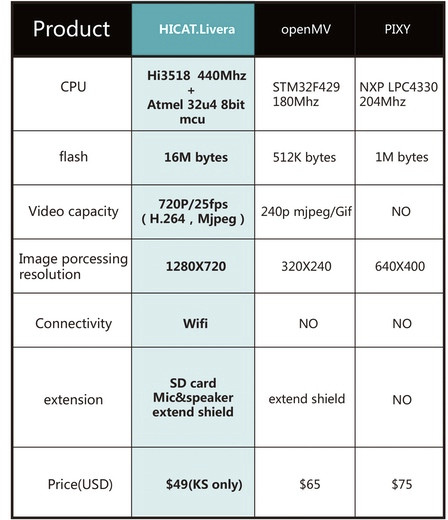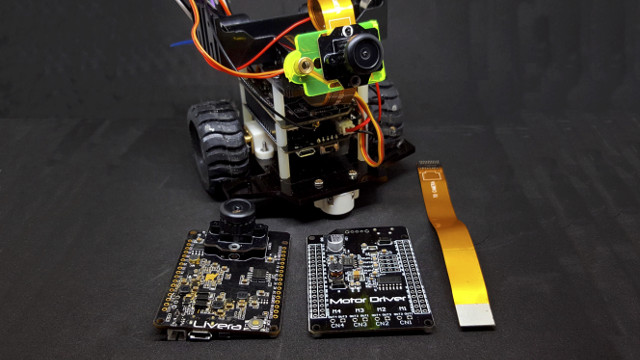HiSilicon Hi3518 ARM9 processor is mostly being used in IP cameras, but Hicat startup decided to combined the camera processor with an Atmel MCU and a MT7601 WiFi module to create a wireless camera board to be used with OpenCV, and even provide a complete affordable robot kit with the board.
 Hicat.livera board specifications:
Hicat.livera board specifications:
- Vision Core – Hisilicon Hi3518 ARM9 processor @ 440 MHz
- Storage – 16MB flash + micro SD card
- MCU – Atmel ATmega32U4 AVR micro-controller
- Connectivity – 802.11 b/g/n WiFi via Mediatek MT7601 module + u.FL antenna connector
- Camera interface with provided 140 deg. camera using Omnivision OV9712 720p (1280×720) sensor
- USB – 1x micro USB port for power and programming
- Audio – Built-in microphone, speaker header
- Sensors – MPU6050 accelerometer and gyro
- Expansion – 2x GPIO headers with GPIOs, I2C, SPI, serial, PWM, digital, analog and power signals.
- Misc – MCU reset and Linux reset buttons,
- Power Supply – 5V via USB or 3.3V LiPo battery
- Dimensions – 60 x 42 mm
They’ve also provide a comparison table between HICAT.Livera and two competing platforms, namely openMV and PIXY.
The firmware in the Hisilicon chip is based on Linux, and includes a video and file streaming server, OpenCV support for object tracking, Node.js support. The ARM9 processor and Atmel MCU communicate over a serial port, and an Arduino library is provided. An Android app (iOS coming soon) can also be used to view the live stream, control the robot, and change settings. Some code is available on Github, but not Linux, which may be an issue to due Hisilicon strict NDA requirements. The developer also claims the project will be open source hardware.
Beside Livera kit with the board and camera, a robot kit is also offered with a extension cable for the camera, a motor driver board based on lv8548 H-Bridge, two DC motors, a servo motor, wheels and body, 9V rechargeable battery, and laser beam. The board and robot are demonstrated in the embedded video.
The project has just launched via Kickstarter, where the goal is to raise $5000 ore more to fund mass production. They have not mentioned the manufacturing partner in Kickstarter, but it should be Seeed Studio, since they informed me about the project. Livera board with camera requires a $39 pledge (Early bird), while the complete robot kit is just $69 (Early Bird). Shipping adds $2 to $20 depending on rewards and destination, and delivery is scheduled for (end of) December 2016 or January 2017.

Jean-Luc started CNX Software in 2010 as a part-time endeavor, before quitting his job as a software engineering manager, and starting to write daily news, and reviews full time later in 2011.
Support CNX Software! Donate via cryptocurrencies, become a Patron on Patreon, or purchase goods on Amazon or Aliexpress






Really cool.
But excuse my ignorance, what can this do that a Raspberry Pi with camera module cannot do?
@Tony
This board has also an ATmega32u4 microcontroller to provide some IO to drive the robot for example. So you would add an Arduino to a Raspberry Pi and a camera and you get the same product but with a lot more power in case of a Raspberry Pi 2 or 3.
The only advantage I see for this solution is that everything is already embedded and the price seem OK. But to run OpenCV, it will be a pain.
really robinCore look similar, maybe better and fail…
for me hi3518 is ok if you can get open source, but a cmos of omnivision mean not very good quality and the most important (to me) bad low light performance.
i guess exmor imx225 is also cheap, and low light is first class.
i would buy 2 robincore if it’ve a imx225, because open os project was good.